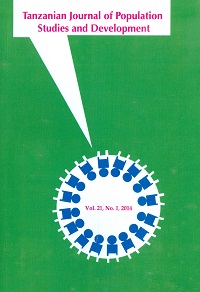The Influence of Healthcare Reforms on Patient-Health Provider Relationships in Chato and Muleba Districts, Tanzania
Abstract
Previous studies on healthcare reforms in Tanzania reported that healthcare provision has improved significantly since the implementation of the ongoing healthcare reforms. However, the influence of the reforms on the nature of patient-health provider relationships has remained unclear. This paper uses data from a study conducted in Chato and Muleba districts to reveal the nature of the relationships and their determinants. Survey questionnaires (390) were administered to healthcare users selected from catchment areas of four health facilities by using systematic random sampling. The study findings indicate that patient-health provider relationships in the study areas are largely paternalistic in both public and private health facilities, but the level of paternalism is significantly higher in the former. Patients under exemption and waiver modes of access to healthcare significantly face more paternalism than their counterparts under user fees and healthcare insurance. A patient experiences mutual or paternalistic patient-health provider relationship depending on one ' s mode of access to healthcare, the level of education, and the type of health facility one attends. Mechanisms need to be devised within the framework of the current healthcare reforms to improve patient-health provider relationships as it is an important aspect in healthcare provision.
References
Andersen, H.M. 2004. Villagers: Differential Treatment in a Ghanaian Hospital. Social Science and Medicine, Vol. 59.
Brook H.R, A.E. McGlynn & P.G. Shekelle. 2000. Defining and Measuring Quality of Care: A Perspective from US Researchers. International Journal of Quality Health Care, Vol. 12
Broom, A. 2005. Virtually Healthy: The Impact of Internet Use on Disease Experience and the Doctor-Patient Relationship. Quality Health Research, Vol. 15.
Buchanan, A. 1978. Medical Paternalism. Philosophy and Public Affairs, Vol. 7.
Charles C., A. Gafni & T. Whelan. 1999. Decision-Making in the Physician-Patient Encounter: Revisiting the Shared Treatment Decision Making Model. Social Science and Medicine, Vol. 49.
Clark, J., A. P. Deborah & J.B. Mckinlay. 1991. Bringing Social Structure Back into Clinical Decision Making. Social Science and Medicine, Vol. 32(8).
Cooper, L.A & N.R. Powe. 2004. Disparities in Patient Experiences, Health Care Processes, and Outcomes: The Role of Patient-Provider Racial, Ethnic and Language Concordance. USA: Johns Hopkins University.
Donabedian, A. 1966. Evaluating the Quality of Medical Care. The Milbank Memorial Fund Quarterly, Vol. 44(3).
Donaldson, M.S. 1999. Measuring the Quality of Health Care: A Statement by the National Roundtable on Health Care Quality. Washington: National Academy Press
Edwards, M., M. Davis, A. Edwards. 2009. What are the External Influences on Information Exchange and Shared Decision Making in Health Care Consultations: A Meta-Synthesis of the Literature. Patient Education and Counseling, Vol. 75.
Emanuel, E. J. & L.L. Emanuel. 1992. Four Models of the Physician-Patient Relationship. Journal of the American Medical Association, Vol. 267(16).
Garfield, S., F. Smith, S.A. Francis & C. Chalmers. 2007. Can Patients ' Preferences for Involvement in Decision-making Regarding the Use of Medicines be Predicted? Patient Education and Counselling, Vol. 66.
Gaudagnoli, E. & Ward, P. 1998. Patient Participation in Decision Masking. Social Science and Medicine, Vol. 47(3).
Giddens, A. 1984. The Constitution of Society: Outline of the Theory of Structuration. http: //esr.oxfordjournals.org/cgi/pdf_extract/1/3/261 retrieved 10th June 2009.
Gilson, L. 1994. Community Satisfaction with Primary Health Care Services: An Evaluation Undertaken in Morogoro Region of Tanzania. Social Science and Medicine, Vol. 39(6).
Goold, S. D. 2001. Trust and the Ethics of Health Care Institutions. Hastings Center Report, Vol. 32(6).
Harrington, J.A. 1998. Privatizing Scarcity: Civil Liability and Health Care in Tanzania. Journal of African Law, Vol. 42.
Henwood, F., S. Wyatt, A. Hart & J. Smith. 2003. Ignorance is Bliss Sometimes: Constrains on the Emergence of the Informed Patients ' in the Changing Landscapes of Health Information. Society Health and Illness, Vol. 25.
Jones, R.I, L. Berney, M. Kelly, L. Doyal, C. Griffiths, G. Feder, S. Hillier, G. Rowlands & S. Curtis. 2004. Is Patient Involvement Possible When Decisions Involve Scarce Resources? A Qualitative Study of Decision-Making in Primary Care. Social Science and Medicine, Vol. 59.
Kettunen, T., M. Poskiparta & M. Gerlander. 2002. Nurse-Patient Relationship: Preliminary Evidence of Patients ' Power Messages. Patient Education and Counselling, Vol. 47.
Khalil, D.D. 2009. Nurses ' Attitude Towards ' Difficult ' and ' Good ' Patients in Eight Public Hospitals. International Journal of Nursing Practice, Vol. 15.
Lazarus, E.S. 1988. Theoretical Considerations for the Study of the Doctor-Patient Relationship: Implications of a Perinatal Study. Medical Anthropology Quarterly, Vol. 2(1).
Loennroth, K., T. Tran, L. Thuong, H. ThiQuy & H. Diwan. 2001. Can I Afford Free Treatment? Perceived Consequences of Health Care Provider Choices Among People with Tuberculosis in Ho Chi Minh City,Vietnam. Social Science and Medicine, 52(6).
Rees, C.E, L.V. Knightb, E. Clare & C.E. Wilkinsonc 2007. Doctors Being Up There and We Being Down Here: A Metaphorical Analysis of Talk About Student/Doctor €“Patient Relationships. Social Science and Medicine, Vol. 65.
Roter D, M. Lipkin & A. Korsgaard. 1991. Sex Differences in Patients' and Physicians' Communication During Primary Care Medical Visits. Medical Care, Vol. 29(1).
Say, R., M. Murtagh & R. Thomson. 2006. Patients ' Preference for Involvement in Medical Decision Making: A Narrative Review. Patient Education and Counselling, Vol. 60.
Shah, B. & B. Chewning. 2006. Conceptualizing and Measuring Pharmacist-Patient Communication: A Review of Published Studies. Research in Social and Administrative Pharmacy, Vol. 2.
Shmueli, A. 2008. The Demand for Clinical Information and for Involvement in Medical Treatment Decision Making: An Empirical Examination in the General Population. The Journal of Socio-Economics, Vol. 37.


